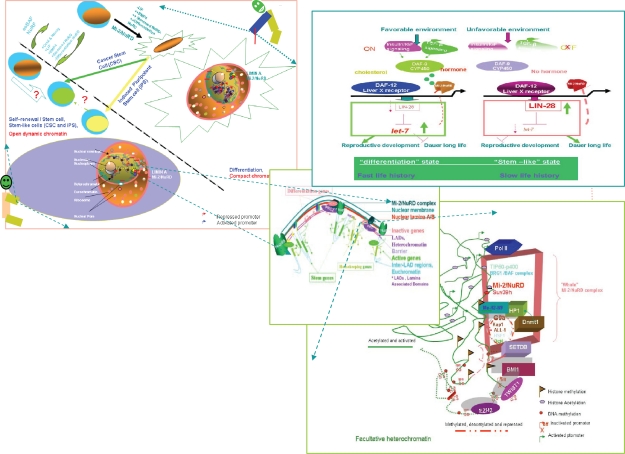Figure 4.
The comprehensive biological and molecular view of the Mi-2/NuRD complexes and SLAC in young mammals and nematode larvae. Upper left: In mammals, the commonality, difference, and mutually induced changes among induced pluripotent stem cells, cancer stem cells, embryonic stem cells and differentiated cells (a high resolution version is presented in Supplementary Fig. 2). Adapted by permission from Macmillan Publishers Ltd: Nature Cell Biology, 2006;8:285–92, copyright 2006.53 Upper right: DAF-12/Liver X receptor and lifespan in Caenorhabditis elegans. In favorable environments, the insulin/IGF-I and transforming growth factor-beta peptide signals converge on the DAF-12/Liver X receptor for the dauer pathways. Cholesterol comes to the DAF-9/cytochrome P450 and a hormone, similar to a sterol-derived dafachronic acid product. The DAF-12/Liver X receptor directs expression of the genes involved in reproductive development, developmental advancements, fat metabolism, and accelerated aging (fast life history traits) mediated by Let-7, LIN-28, and a feedback loop that the Mi-2/NuRD complex is postulated to be involved in. In unfavorable environments, hormonal pathways are suppressed. Unliganded DAF-12 specifies programs for dauer diapause, delayed development, fat storage, and retarded aging (slow life history traits). This process is also mediated by LET-7, LIN-28, and a feedback loop that the Mi-2/NuRD complex is postulated to be involved in (see Supplementary Fig. 3). Middle: Model of the dynamic pop-up and inward gene positioning of nuclear lamina-genome interactions during self-renewal and differentiation in Caenorhabditis elegans. Two major forces drive tissue-specific subnuclear organization of the worm genome, ie, repeat-induced heterochromatin, which associates with the nuclear envelope, and tissue-specific promoters that shift inward in a dominant fashion when they are activated. Tissue-specific promoters shift in a nondominant manner to the nuclear envelope in cells in which they are inactive (Supplementary Figs. 4A and 4B). Bottom: The dynamic interchanges between euchromatin and heterochromatin in stemness and differentiation states. The putative “all-in-one Mi-2/NuRD supercomplex is highlighted” other different “isoforms” of Mi-2/NuRD complexes, include at least the activator-only Mi-2/NuRD complexes and the repressor-only Mi-2/NuRD complexes (see Supplementary Fig. 5).

